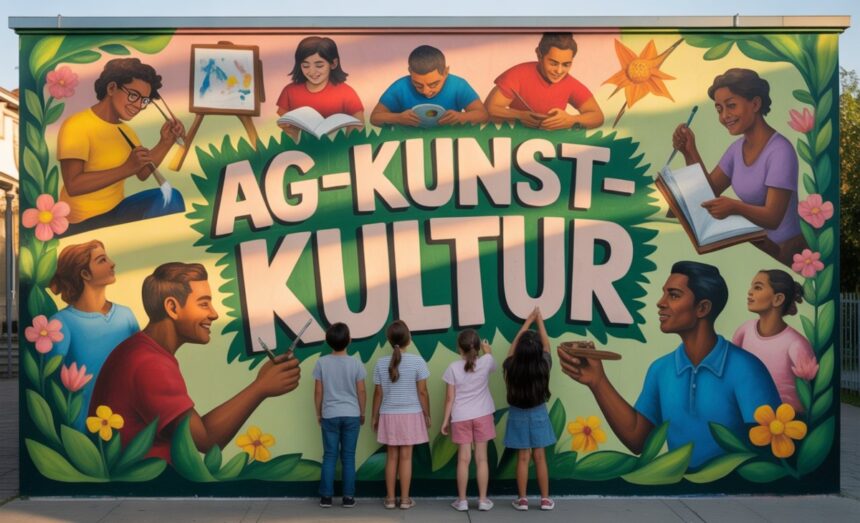The phrase “AG-Kunst-Kultur” translates from German as Art and Culture Working Group. It represents a collective, initiative, or association that unites individuals, organizations, and institutions dedicated to promoting the role of art and culture in society. Whether in universities, cultural institutions, or community-driven projects, AG-Kunst-Kultur reflects how collaboration in creative fields contributes to education, social cohesion, and cultural innovation.
In this guide, we will explore everything about AG-Kunst-Kultur—its meaning, historical background, role in education, societal impact, cultural importance, and future relevance.
What Does AG-Kunst-Kultur Mean?
The term can be broken down into three parts:
- AG (Arbeitsgemeinschaft): In German, this means a working group or association formed to pursue a common interest.
- Kunst: Refers to art, encompassing visual arts, performing arts, design, and creative expression.
- Kultur: Refers to culture, the collective practices, traditions, values, and expressions of societies.
Together, AG-Kunst-Kultur symbolizes a collaborative framework where art and culture intersect to inspire, educate, and shape communities.
Historical Background of AG-Kunst-Kultur
Roots in German Cultural Policy
Germany has a long tradition of supporting artistic and cultural collectives. After World War II, cultural reconstruction was considered vital for national identity and education. Universities, schools, and municipalities began forming AGs (Arbeitsgemeinschaften) dedicated to arts and culture.
Evolution in Education and Communities
By the 1970s and 1980s, AG-Kunst-Kultur became a recognized extracurricular activity in schools and universities, offering students opportunities to:
- Participate in theater, music, or visual art groups.
- Engage in cross-cultural exchanges.
- Explore art history and cultural theory alongside practice.
Today, the concept has expanded beyond schools, encompassing nonprofits, cultural centers, and international collaborations.
Objectives of AG-Kunst-Kultur
The primary mission of AG-Kunst-Kultur initiatives includes:
- Promoting Creative Education: Offering young people and adults structured access to art and cultural practices.
- Cultural Preservation: Safeguarding traditions while promoting innovation in contemporary art.
- Social Inclusion: Encouraging participation across diverse social and cultural groups.
- Fostering Interdisciplinary Dialogue: Bridging art with technology, science, and social issues.
Key Features of AG-Kunst-Kultur
1. Collaboration
AG-Kunst-Kultur thrives on collective effort. Artists, educators, policymakers, and students collaborate to shape cultural projects.
2. Diversity of Expression
It embraces all forms of art—visual art, music, theater, dance, literature, digital media, and architecture—within cultural contexts.
3. Accessibility
One of its central principles is making art and culture accessible to everyone, regardless of socioeconomic status or educational background.
4. Lifelong Learning
It is programs promote cultural education for all ages, from schoolchildren to adults.
The Role of AG-Kunst-Kultur in Education
Education is a cornerstone of AG-Kunst-Kultur’s activities.
In Schools
- Offers extracurricular clubs where students explore painting, theater, or music.
- Connects classroom knowledge with practical creativity.
- Encourages teamwork, critical thinking, and self-expression.
In Universities
- Provides research opportunities in art history, cultural studies, and creative industries.
- Encourages cross-disciplinary collaboration with sociology, philosophy, or digital technology.
Lifelong Cultural Learning
- Adult education centers (Volkshochschulen) often include courses.
- Workshops and community programs bring art closer to local populations.
Cultural Impact of AG-Kunst-Kultur
Preserving Heritage
These initiatives protect and promote regional and national cultural identities through exhibitions, performances, and archives.
Driving Innovation
By supporting new artistic forms, It is contributes to cultural innovation in digital art, media, and performance.
Promoting Diversity
It is programs foster intercultural understanding in increasingly diverse societies.
AG-Kunst-Kultur and Society
Building Community
Community-based projects under, It is enhance social cohesion by providing inclusive spaces for artistic collaboration.
Encouraging Civic Engagement
Art and culture initiatives foster public dialogue on pressing social issues such as sustainability, migration, and identity.
Strengthening Local Economies
Cultural events organized by attract tourism and support creative industries.
Case Studies of AG-Kunst-Kultur in Action
School-Based Example
A German secondary school forms an club to stage annual theater productions. Students not only act but also design costumes, build sets, and manage sound—learning both artistic and technical skills.
Community Center Example
A cultural center partners with organize multicultural festivals, featuring dance, music, and food from different ethnic groups.
University Example
A university’s organizes interdisciplinary symposiums on art and technology, bringing together artists, engineers, and sociologists.
Challenges Facing AG-Kunst-Kultur
- Funding: Many groups depend on government or nonprofit funding, which can be limited.
- Accessibility: Reaching underprivileged groups remains a challenge.
- Digital Transformation: Balancing traditional cultural practices with new digital platforms.
- Globalization: Preserving local identity while embracing international influences.
The Future of AG-Kunst-Kultur
Digital Integration
Expect greater use of virtual platforms, digital exhibitions, and online performances.
Cross-Sector Collaboration
Art and culture will increasingly intersect with science, healthcare, and sustainability projects.
Expanding Inclusivity
Future initiatives will prioritize social justice, equity, and representation in cultural projects.
International Reach
It will continue to expand globally through exchange programs and cultural diplomacy.
Why AG-Kunst-Kultur Matters Today
It is more than an organizational concept—it is a cultural philosophy. It demonstrates how creativity and cultural awareness can:
- Strengthen education systems.
- Enrich community life.
- Build bridges across cultural and social divides.
By supporting such initiatives, societies invest in creativity, empathy, and resilience—qualities essential for the challenges of the modern world.
Conclusion
It is embodies the essential partnership between art and culture in education, society, and innovation. It highlights the power of collaboration, the importance of cultural preservation, and the necessity of inclusivity in creative expression.
From schools and universities to community centers and international collaborations, It is demonstrates that art and culture are not luxuries but fundamental components of human life.
As we move into the digital age, AG-Kunst-Kultur remains an inspiring model for how creativity and collaboration can shape a better, more connected future.







